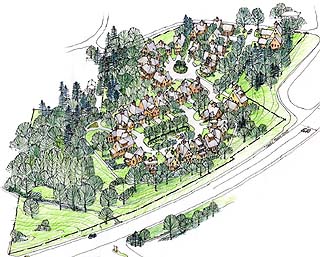
Surveys
DJC.COM
July 29, 2004
Low-impact development comes to Pierce County
AHBL

Zickler
|
Over the last few years, Pierce County has been evaluating several regulatory options in response to challenges the region faces in managing its stormwater resources. The county is taking a comprehensive look at how stormwater is managed, both in terms of volume and quality.
One of the options being investigated is the application of low impact development (LID) techniques as a viable option to manage both volumes and water quality in the south Puget Sound region.
Building on data, research and case studies evaluating the potential benefits for the application of a range of LID technologies, Pierce County entered into a partnership with a local developer to complete the Meadow on the Hylebos as a demonstration project. The development community, which was somewhat skeptical of the LID techniques under study, opposed the broad application of a proposed county LID ordinance until more data was available. The Meadow on the Hylebos project is intended to provide this information.
What is LID?

Image courtesy AHBL
The Meadow on the Hylebos subdivision site has wetlands, steep slopes and forests and sits on Hylebos Creek. |
LID is a new land use development and storm drainage management strategy emphasizing the maintenance and restoration of natural, pre-developed watershed hydrological functions. The goal of LID is to generate no measurable impacts to aquatic environments by maintaining and/or restoring the pre-developed stormwater flow volumes, rates, frequencies, durations and quality.
Natural, pre-developed watersheds achieve a balance between overland stormwater flows, infiltration, storage and evapotranspiration. LID strategies apply site and building development techniques designed to maintain these natural functions.
The LID design process assesses existing site soils, native vegetative cover, sensitive areas and drainage characteristics of the site and surrounding watershed. Consistent with the over-reaching goal of LID, the design process focuses on protecting, maintaining and/or restoring these natural features.
Public-private partnership
During the summer of 2003, Pierce County became "co-applicant" with the property owners, David Mahlman and Don Olson (Don Olson Construction), for the development of the Meadow on the Hylebos. Homes are expected to be finished by summer 2005 by home builder Reich Construction.
The project will include a variety of LID technologies, demonstrating the application and potential benefits of the various LID stormwater management features. For the developer's part, the LID technologies proposed were of much interest, as the development approval process was greatly streamlined and enhanced through this approach. The application of LID technology to the site greatly reduced the entitlement process, reducing the approval timeline by at least six months.
An ideal site for LID
The site is located on a 9-acre parcel in north Pierce County, adjacent to the city of Fife. What makes the site appealing for the application of LID technologies is its location on Hylebos Creek.
The Hylebos is a stream draining large portions of southern King County and northern Pierce County. Years of work have focused on improving the water quality and function of the Hylebos as a salmon-bearing resource.
The site is also appealing as a LID demonstration site because of its inherent challenges, including wetlands, steep slopes, native forest areas and glacial till soils — all characteristic of many of the remaining development sites throughout the Puget Sound region. Our belief is that if LID technology will work on this site, it will work anywhere.
Working closely with Pierce County engineering staff, a design was developed which proposed clustering of the residential units, preserving approximately half the site as open space. Portions of the site which had been cleared or planted in lawn will be rehabilitated to a more natural woodland condition. This restoration, coupled with a 150-foot buffer along the Hylebos, will greatly enhance the natural drainage characteristics of the site.
One of the challenges of the project was a requirement by the fire marshal to maintain a roadway width of at least 24 feet. An important objective of LID is to minimize impervious surfaces, and often times narrow roadways are proposed to accomplish this. The original proposal was for a 20-foot paved roadway. The final design uses a 22-foot paved travel way with a 2-foot pervious concrete shoulder. Since this is a roadway configuration that does not appear in Pierce County standard details, a deviation was requested and granted by the county engineer.
Roof drainage from all homes will be directed to a swale system that includes extensively rehabilitated soil. These swales will then direct stormwater to rain gardens, which will detain and infiltrate the water, as well as convey stormwater during larger storm events. Approximately two-thirds of the homes will include a rain garden feature.
Drainage from the swales and rain gardens will then be directed to a small detention facility; one of the few conventional stormwater management techniques used in the design. After leaving the pond, the stormwater will be directed to a sloped bio-terrace system designed to carefully release the drainage down slope to Hylebos Creek.
Construction cost savings
Detailed construction cost estimates have been prepared for on-site and off-site improvements related to the plat project. These cost estimates were necessary to support the ultimate sale price for the lots.
The detailed construction cost opinion was evaluated against the original conventional plat design. The original design included wide roadways, sidewalks on both sides of the road, a pipe conveyance system, and a very large storm detention pond.
Through the application of the proposed LID technology, the conventional storm pond size was reduced by two-thirds. The cost comparisons between the conventional design and the proposed LID design resulted in an approximate 9 percent cost savings to the developer.
Site will be monitored
To evaluate the performance of the project's many LID features, a comprehensive monitoring program will be employed at the site for at least three years following construction. Curtis Hinman, a Puget Sound water quality field agent at Washington State University at Tacoma, will lead this effort.
Hinman has been monitoring the site for more than a year so that the site's hydrological performance before and after construction can be compared. An on-site weather station measures the amount of rainfall at the site, and numerous sensors and wells assess the flow of water on and below the surface.
"It's one of the most extensively monitored sites in the country," Hinman says. Besides providing a basis for assessing the project's performance, the results from the monitoring program will be used by Washington's Department of Ecology as it develops guidelines for LID, he says.
Len Zickler, AICP, ASLA, is a principal with AHBL Tacoma. His recent work has included policy and regulatory development, and specific project design application of LID technologies.
Other Stories:
- Conditional closures — another cleanup remedy
- Washington tests watershed management
- Todd Pacific halts a dirty waterfront legacy
- Going green? Try calling on your contractor
- Emerald City must fight to stay green
- Seattle prepares to ‘re-green' 2,500 acres
- Washington's new paint law gets the lead out
- Putting a price tag on nature
- South Lake Union: a model for sustainability
- Guy Battle: design and build to suit your climate
- Contractor finds silver at new headquarters
- Government finds gold at Sea-Tac Airport
- 2004: A great year for the local environment
- Getting to compliance with a systems approach
- Don't let your site be taken to the cleaners
- Salmon get a boost from technology
- Energy Star label now ready for homes
- Improving traffic flow for fish, people
- Troubling times for Hood Canal's waters
- Quick Duwamish cleanup begins with teamwork
- Utilities to study energy coming into homes
Copyright ©2009 Seattle Daily Journal and DJC.COM.
Comments? Questions? Contact us.